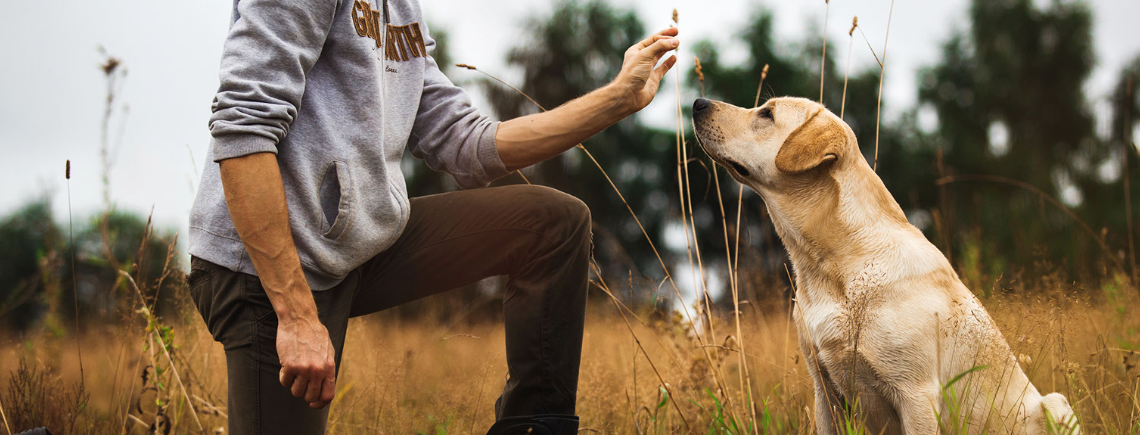Command Training Your Dog (Sit, Stay, Lie Down)
Training your dog the basics of obedience is an important responsibility as a pet owner. A dog that will respond to your commands and come back when called will help keep him out of harm’s way and going missing. I always recommend training your dog as soon as possible. For a puppy, as soon as you get them between 8-12 weeks, light training such as house training or crate training can be done at this stage. When your dog is between 4-6 months old and has a longer attention span, you can begin teaching him new commands.
With some patience, plenty of treats and attention, you will have him trained to do basic commands in no time.

Samantha Rawson CAAB
Champion dog trainer Samantha Rawson is a certified behaviour & training consultant with almost thirty years of experience the Canine College. She has trained two rescue dogs to IKC working trials champions. Samantha is the regular dog expert on KCLR96FM and The Ray D’arcy Show on RTE Radio 1. She is passionate about dogs and their mental physical and emotional welfare. Samantha believes in relationship based training founded on trust respect and play.
What Equipment You’ll Need
What To Remember
Only when our dogs understand the behaviour, then we can put a cue word (such as ‘come’, ‘stay’, or ‘release’) or a signal (such as waving or holding up your hand)
- The dog must be on a lead.
- The dog must know his name and be able to respond.
- The dog must be motivated-if your dog is not motivated by treats, I suggest using toys. This can depend on your dog’s age, breed, confidence level and personal preferences.
- Training in a familiar environment and helping them get used to the commands is useful.
- Never call a dog out of a stay. You must always return to your dog, for your safety.
Teaching Your Dog To Sit
- Lure your dog into the sit position by holding a treat over their nose. Your index finger should be pointing upwards towards the sky (this is your hand signal). When they are in the correct position (when their bum hits the floor!), reward them with a treat.
- Use your ‘release’ command such as ‘okay’ or ‘finish’ and move them. Repeat as above and when they sit, reward.
- When your dog starts to understand this behaviour, add a cue which can be a signal and/or command. Many dogs prefer hand signals as it is easier to understand.
Sitting has many uses; it can counteract undesirable behaviour such as jumping on people and keeping your dog under control. Training your dog to sit helps to maintain a calm, controlled behaviour many of us want.


Teaching Your Dog To Stay
- Introduce your dog to a ‘stay location’ by using a mat, bed or blanket.
- Reward the dog whenever they investigate or go near the mat by throwing treats directly onto the mat to help build a strong association that the mat is a good place to be. While you are doing this, provide plenty of praise and smiles.
- The idea is to teach the dog to associate the mat with lots of treats. Give you dog the ‘release’ command, and walk him off the mat. This will teach your dog to understand that no mat, means no reward.
- When your dog has associated the mat with treats, then you can introduce your stay signal (the palm of your hand). Command the dog to stay and take two steps away. If he stays, return and reward them on the mat. Repeat this at least three times, give him the ‘release’ command, and walk him off the mat.
- Using the mat helps the dog to understand where you want them to stay. It is important to remember if the dog doesn’t stay on the mat, they don’t receive any rewards-they will eventually associate staying on the mat with plenty of praise and treats.
- Once the lesson is finished, remove the mat. Try practicing this in different locations such in different rooms in your house and different areas of your garden before taking it public. Always make sure your dog feels safe.
Teaching Your Dog To Lie Down
- Introduce your dog to a mat, blanket or bed, and wait for them to sit.
- Once sitting, lure them into the down position by asking them to follow a treat in a straight line from their nose down to the floor.
- Once they understand the behaviour, you can introduce the command or signal for ‘down’. Use the same signal every time you ask them to lie down to ensure your dog understands the signal and command. Then give them their ‘release’ command such as ‘finish’ or ‘okay’ and walk them off the mat. Remember, no mat, no rewards!
- Practice the signal and command and make sure to provide plenty of praise and tasty treats throughout the entire process to make it more fun and rewarding for your dog.
Remember!
It’s very important for your dog to be given the opportunity to play afterwards and to relax in order for them to process the lesson. If your dog is struggling to understand you, they might be too young; take a break, and try again. If you are still struggling with this, check out my website here.
Got a Question?
As always, the Petmania staff will be able to assist you in making the right choice for your dog when it comes to training equipment, treats and more. If you have any questions at all, be sure to pop in store or message online and they’d be happy to help. For more on training your dog and expert behavioural tips, be sure to visit my website here.


